|
Dedicated
to the Art
and
Artists
of Relief Printmaking
15685
SW 116th Avenue
PMB 202
King City, OR 97224-2695
Phone:
503-641-3555
FAX:
503-641-3591
Orders:
800-832-4264
imcclains.com
Go
to McClain's
On-line Catalog
Request
a catalog
[
Unsubscribe] |
March,
2005
| Dear
Friends,
The Artist Profile is a new feature to our newsletter. We
talk with printmakers about their artistic experiences so
you can benefit from their answers!
We recently spoke to Elaine Chandler, previous owner of McClain's
and cover artist of our new 2005 catalog (see the first
print ). Elaine has been a professional printmaker
for 22 years and specializes in Moku Hanga (Japanese
woodblock printmaking).
McClain's:
What inspires you to make Japanese style prints?
Elaine Chandler: Japanese wood block prints have
many of the attributes of watercolor paintings. It is the
ability to layer colors while maintaining the transparency
and luminosity of the color that appeals to me. The requirements
for setting up a print studio in this medium are fairly nominal
and pretty low tech when compared to other printmaking techniques. Even
the kitchen table will suffice as studio space. I like the
entire process from the tactile pleasure of carving the wood
to the flexibility of printing by hand. And of course the
medium is non-toxic and the cleanup is easy: no acid or solvent
fumes to vent.
|
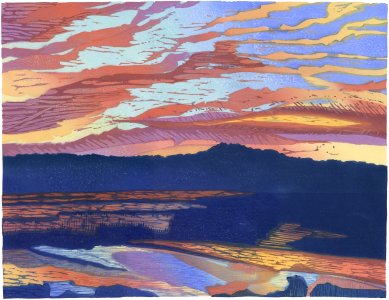
Early
one Morning..., 12 x 15
| 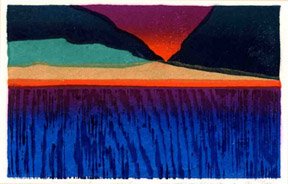
|
The
Reach
3
x 4 |
Nexus
II, 5 x 4 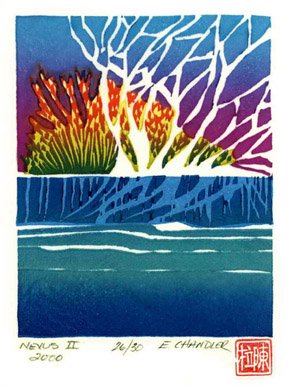
|
McClain's:
How do you achieve such intense color?
Elaine Chandler: Intensity of color is the
result of several things. First of all, I use highly
pigmented ink such as Akua-Kolor, or high quality gouache
and watercolors. Second, I may print a single
area several times to saturate the color. Third,
without going into the principles of color theory, I take
advantage of the juxtaposition of colors to enhance what the
eye sees. And, fourth, the intensity and luminosity of color
depends a great deal upon the paper one uses. The
long fibers of Japanese Washi are actually dyed,
accept multiple printings, and give back color in a manner
no other paper seems able achieve. Of the Washi
carried by McClain's, my favorites, in order, are
Echizen Kozo,
Nishinouchi,
and Kizuki Hanga.
I especially like the Echizen Kozo for ease of printing: it requires little pressure
from the baren and holds up well to handling. I've been able
to print a 12" x 24" piece multiple times without difficulty
and the printed color turns out lovely.
Click here to continue this interview... |
_________________________________________________________________________
TIPS________________________________________________________________
| Making
a damp Pack
A
damp pack is necessary to properly moisten Washi
(handmade paper) for printing. Moist paper improves the
fibers ability to absorb pigment.
There
are many ways to make a damp pack; this is the way that works
for us.
Cut
a sheet of plastic big enough to wrap around the Washi
once plus a little more to tuck in along the sides.
Trash bags work great for paper small enough to fit inside.
You'll need at least 3-4 sheets of newsprint per one sheet
of Washi . Some printmakers use old flattened newspapers
instead of newsprint. This is great for recycling but newspaper
ink can offset onto your beautiful Washi . The older
the newspaper the less likely this will happen.
Now,
evenly moisten the newsprint. If using a spray bottle mist
every sheet. If using a Mizu Bake,
(Japanese water brush) dampen every other
sheet. The newsprint should NOT be dripping wet, just moist.
Leave
three damps sheets of newsprint on the bottom of the stack.
Place one sheet of dry Washi between 2 - 3 moist
sheets of newsprint. End with three damp sheets of newsprint
on top. Wrap the entire stack of papers in plastic to ensure
that the paper stays moist.
Put
the stack under flat weights (not too heavy, one or two plywood
boards work fine). Allow the paper to sit for 2 to 5 hours.
Some sources recommend leaving the paper in the damp pack
overnight if there are many sheets. As a general rule of thumb,
the paper should feel cool to the touch, not wet.
When
you are ready to print, take the damp pack out of the plastic
bag and spread a moistened towel on top and underneath to
prevent further evaporation.
It
must be said that there is no magic formula for determining
the correct degree of moisture. This will change according
to paper fiber structure, thickness, the strength of the paper's
sizing (if present), and the temperature and humidity of the
workshop.
WARNING!
Soaking handmade papers in a bath or tray instead of a damp
pack will over saturate and ruin the paper. |
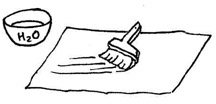 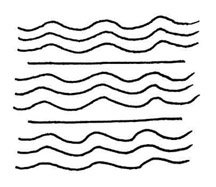
wavy
line = newsprint
straight
line = print paper
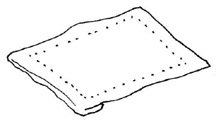
 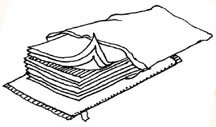
|
_________________________________________________________________________
PRODUCTS____________________________________________________
Akua-Kolor
Water-Based Ink Sets
If you've never printed with water-based inks before, this
is your opportunity to test the best. There is no ink like
Akua-Kolor. Developed
for monotype printmaking, Akua-Kolor also works straight out
of the bottle for Japanese style printmaking. Or,
add Tack Thickener and roll out the ink with a brayer. This
slow drying ink gives the artist a long working time on the
plate or block, and an exceptionally rich working consistency. No
chalk, fillers, polymers or resins are added to this heavily
pigmented ink. Prints dry to a velvety matte finish
with brilliant, luminous color.
Akua-Kolor inks are now available in a variety of sets designed
to save you money!
Akua-Kolor Trial Set $28.00
Akua-Kolor Woodblock and Linocut Set
(save $5.10) $48.75
Akua-Kolor Introductory Set
(save
$10.25) $113.25
Akua-Kolor Professional Set
(save
$30.85) $279.50
Washi
(Japanese Handmade Paper)
Nishinouchi is
one of our finest papers and is recommended by many of our
customers, including Elaine Chandler, this month's featured
artist. Long fibers make it surprisingly strong
and able to withstand repeated printings from multiple blocks. The
texture and naturally warm color of the paper adds liveliness
to a print while giving back sharp, crisp colors from water-based
inks. It tears easily and is ideal for woodcut,
linocut, monotype, and book arts. At 29.25 x 41.75,
it is the largest paper we carry.
1-10 sheets $12.90
11-50
sheets $12.25
50+
sheets $10.95
Nothing compares to seeing and feeling the paper itself. Our
Washi Sample Book
allows you to do so before investing in full sheets of paper. It
Includes 3 x 5 sample of every paper we carry as well as a
list describing each paper in detail.
$6.00
|
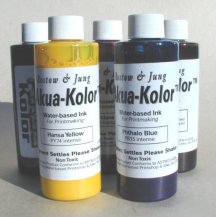
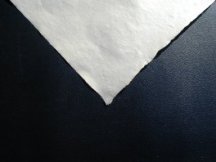
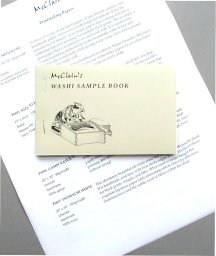
|
_________________________________________________________________________
NEWS______________________________________________________________
McClain's
will be taking part in the product fair at Power in Print,
the Southern Graphics Council International Conference March
31 - April 2, 2005, at the Capital Hilton in Washington DC. Redeem
this coupon
at our table for a special offer. We hope to see
you there!
Because of the SGC conference, McClain's will be closed from March 29 - April 1.
Artists! On our website, we have compiled an extensive
list of printmaking resources, links and opportunities. Find
out about instructors, classes, schools, printmaking organizations,
special events, and competitions from all over the world. Please
contact us if you'd like to add a new posting.
Click here to visit our calendar and links page.
Have you noticed anything different about us? McClain's
has a new look! To start the new year, we treated
ourselves a new logo courtesy of Fancypants Design. To
see more of their work, go to www.fancypantsdesign.com .
|
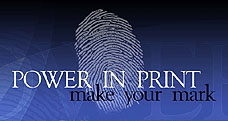
|
__________________________________________________________________________
|












